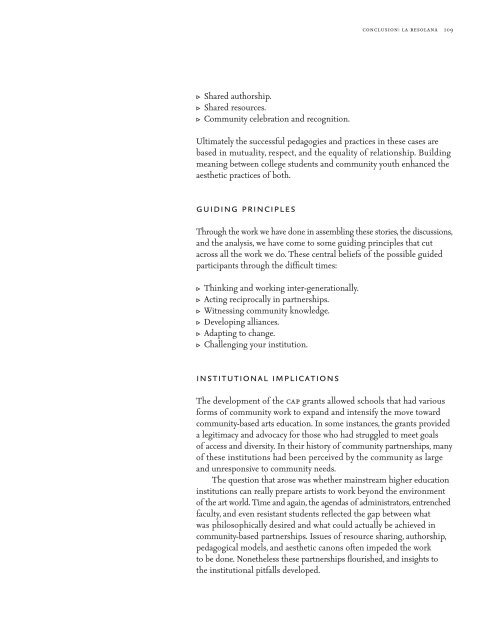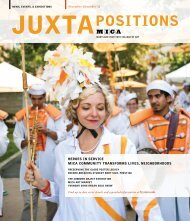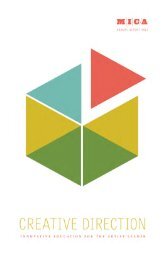art/vision/voice - Maryland Institute College of Art
art/vision/voice - Maryland Institute College of Art
art/vision/voice - Maryland Institute College of Art
Create successful ePaper yourself
Turn your PDF publications into a flip-book with our unique Google optimized e-Paper software.
v Shared authorship.<br />
v Shared resources.<br />
v Community celebration and recognition.<br />
Ultimately the successful pedagogies and practices in these cases are<br />
based in mutuality, respect, and the equality <strong>of</strong> relationship. Building<br />
meaning between college students and community youth enhanced the<br />
aesthetic practices <strong>of</strong> both.<br />
guiding principles<br />
Through the work we have done in assembling these stories, the discussions,<br />
and the analysis, we have come to some guiding principles that cut<br />
across all the work we do. These central beliefs <strong>of</strong> the possible guided<br />
p<strong>art</strong>icipants through the difficult times:<br />
v Thinking and working inter-generationally.<br />
v Acting reciprocally in p<strong>art</strong>nerships.<br />
v Witnessing community knowledge.<br />
v Developing alliances.<br />
v Adapting to change.<br />
v Challenging your institution.<br />
institutional implications<br />
conclusion: la resolana 109<br />
The development <strong>of</strong> the cap grants allowed schools that had various<br />
forms <strong>of</strong> community work to expand and intensify the move toward<br />
community-based <strong>art</strong>s education. In some instances, the grants provided<br />
a legitimacy and advocacy for those who had struggled to meet goals<br />
<strong>of</strong> access and diversity. In their history <strong>of</strong> community p<strong>art</strong>nerships, many<br />
<strong>of</strong> these institutions had been perceived by the community as large<br />
and unresponsive to community needs.<br />
The question that arose was whether mainstream higher education<br />
institutions can really prepare <strong>art</strong>ists to work beyond the environment<br />
<strong>of</strong> the <strong>art</strong> world. Time and again, the agendas <strong>of</strong> administrators, entrenched<br />
faculty, and even resistant students reflected the gap between what<br />
was philosophically desired and what could actually be achieved in<br />
community-based p<strong>art</strong>nerships. Issues <strong>of</strong> resource sharing, authorship,<br />
pedagogical models, and aesthetic canons <strong>of</strong>ten impeded the work<br />
to be done. Nonetheless these p<strong>art</strong>nerships flourished, and insights to<br />
the institutional pitfalls developed.
















